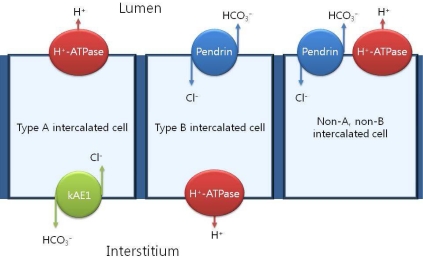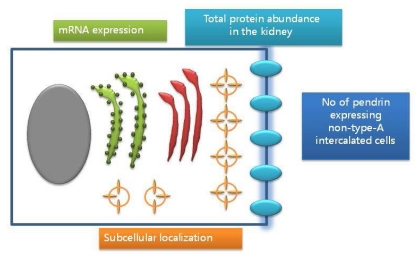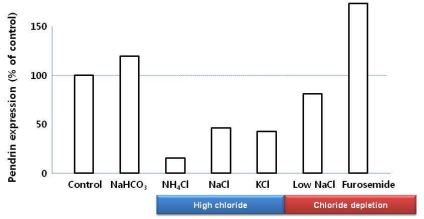Electrolyte Blood Press.
2009 Jun;7(1):20-24. 10.5049/EBP.2009.7.1.20.
Role of Pendrin in Acid: base Balance
- Affiliations
-
- 1Department of Internal Medicine, Laboratory of Molecular Nephrology, Gachon University of Medicine and Science, Incheon, Korea. imsejoong@hanmail.net
- KMID: 1464785
- DOI: http://doi.org/10.5049/EBP.2009.7.1.20
Abstract
- Pendrin (SLC26A4) is a Na+-independent Cl-/HCO3- exchanger which is expressed in the apical membranes of type B and non-A, non-B intercalated cells within the distal convoluted tubule, the connecting tubule, and the cortical collecting duct. In those segments it mediates HCO3- secretion and chloride (Cl-) absorption. In mice, no renal abnormalities are observed under basal conditions, and individuals with genetic disruption of the pendrin (SLC26A4) gene (Pendred syndrome) have normal acid-base balance. In contrast, there are definite differences under conditions wherein the transporter is stimulated. In animal studies, pendrin (SLC26A4) is upregulated with aldosterone analogues, Cl- restriction, and metabolic alkalosis, and is down-regulated with Cl loading and metabolic acidosis, independently. However, the exact role of pendrin in humans has not been established to date, and further examinations are necessary.
Keyword
MeSH Terms
Figure
Reference
-
1. Alper SL. Genetic diseases of acid-base transporters. Annu Rev Physiol. 2002; 64:899–923. PMID: 11826292.
Article2. Dinour D, Chang MH, Satoh J, Smith BL, Angle N, Knecht A, et al. A novel missense mutation in the sodium bicarbonate cotransporter (NBCe1/SLC4A4) causes proximal tubular acidosis and glaucoma through ion transport defects. J Biol Chem. 2004; 279:52238–52246. PMID: 15471865.
Article3. Wagner CA, Geibel JP. Acid-base transport in the collecting duct. J Nephrol. 2002; 15(Suppl 5):S112–S127. PMID: 12027210.4. Alper SL, Natale J, Gluck S, Lodish HF, Brown D. Subtypes of intercalated cells in rat kidney collecting duct defined by antibodies against erythroid band 3 and renal vacuolar H+-ATPase. Proc Natl Acad Sci USA. 1989; 86:5429–5433. PMID: 2526338.5. Schuster VL. Function and regulation of collecting duct intercalated cells. Annu Rev Physiol. 1993; 55:267–288. PMID: 8466177.
Article6. Kim YH, Kwon TH, Frische S, Kim J, Tisher CC, Madsen KM, et al. Immunocytochemical localization of pendrin in intercalated cell subtypes in rat and mouse kidney. Am J Physiol Renal Physiol. 2002; 283:F744–F754. PMID: 12217866.7. Wall SM, Hassell KA, Royaux IE, Green ED, Chang JY, Shipley GL, et al. Localization of pendrin in mouse kidney. Am J Physiol Renal Physiol. 2003; 284:F229–F241. PMID: 12388426.
Article8. Verlander JW, Hassell KA, Royaux IE, Glapion DM, Wang ME, Everett LA, et al. Deoxycorticosterone upregulates PDS (Slc26a4) in mouse kidney: role of pendrin in mineralocorticoid-induced hypertension. Hypertension. 2003; 42:356–362. PMID: 12925556.9. Everett LA, Glaser B, Beck JC, Idol JR, Buchs A, Heyman M, et al. Pendred syndrome is caused by mutations in a putative sulphate transporter gene (PDS). Nat Genet. 1997; 17:411–422. PMID: 9398842.
Article10. Sindic A, Chang MH, Mount DB, Romero MF. Renal physiology of SLC26 anion exchangers. Curr Opin Nephrol Hypertens. 2007; 16:484–490. PMID: 17693766.11. Wagner CA, Devuyst O, Bourgeois S, Mohebbi N. Regulated acid-base transport in the collecting duct. Pflugers Arch. 2009; 458:137–156. PMID: 19277700.
Article12. Adler L, Efrati E, Zelikovic I. Molecular mechanisms of epithelial cell-specific expression and regulation of the human anion exchanger (pendrin) gene. Am J Physiol Cell Physiol. 2008; 294:C1261–C1276. PMID: 18322141.
Article13. Frische S, Kwon TH, Frokiaer J, Madsen KM, Nielsen S. Regulated expression of pendrin in rat kidney in response to chronic NH4Cl or NaHCO3 loading. Am J Physiol Renal Physiol. 2003; 284:F584–F593. PMID: 12556366.14. Hafner P, Grimaldi R, Capuano P, Capasso G, Wagner CA. Pendrin in the mouse kidney is primarily regulated by Clexcretion but also by systemic metabolic acidosis. Am J Physiol Cell Physiol. 2008; 295:C1658–C1667. PMID: 18971389.
Article15. Wagner CA, Finberg KE, Stehberger PA, Lifton RP, Giebisch GH, Aronson PS, et al. Regulation of the expression of the Cl-/anion exchanger pendrin in mouse kidney by acid-base status. Kidney Int. 2002; 62:2109–2117. PMID: 12427135.
Article16. Quentin F, Chambrey R, Trinh-Trang-Tan MM, Fysekidis M, Cambillau M, Paillard M, et al. The Cl-/HCO3- exchanger pendrin in the rat kidney is regulated in response to chronic alterations in chloride balance. Am J Physiol Renal Physiol. 2004; 287:F1179–F1188. PMID: 15292050.17. Royaux IE, Wall SM, Karniski LP, Everett LA, Suzuki K, Knepper MA, et al. Pendrin, encoded by the Pendred syndrome gene, resides in the apical region of renal intercalated cells and mediates bicarbonate secretion. Proc Natl Acad Sci USA. 2001; 98:4221–4226. PMID: 11274445.
Article18. Wall SM, Kim YH, Stanley L, Glapion DM, Everett LA, Green ED, et al. NaCl restriction upregulates renal Slc26a4 through subcellular redistribution: role in Cl- conservation. Hypertension. 2004; 44:982–987. PMID: 15477386.
- Full Text Links
- Actions
-
Cited
- CITED
-
- Close
- Share
- Similar articles
-
- Renal intercalated cells and blood pressure regulation
- Study about Hypothermic - anesthesia during Intraperitoneal Hyperthermo - chemotherapeutic Perfusion Combined with Surgery in Far - advanced Stomach Cancer
- Metabolic Disorders of Acid Base Balance
- Disorders of Mineral Metabolism & Acid-Base Balance
- The Effect of Intraoperative Fluid Therapy ( 5% Dextrose Solntion and Hartmann`s Solution ) on Acid-Base Balance




